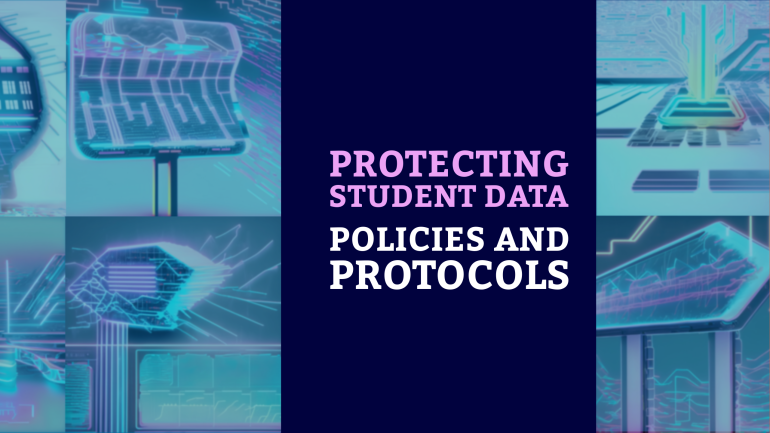Table of Contents
TL;DR: Safeguarding the Future: The Critical Role of Student Data Protection in Education
- Establish clear policies and protocols: It is crucial for educational institutions to have well-defined policies and protocols in place to protect student data.
- Limit access to sensitive information: Only authorized personnel should have access to student data, and access should be restricted based on job responsibilities.
- Train staff on data security: Providing regular training to staff members on data security best practices can help prevent data breaches and ensure compliance with regulations.
- Secure data storage and transmission: Student data should be stored securely using encryption and other security measures, and transmission of data should be done through secure channels.
- Monitor and audit data access: Regular monitoring and auditing of data access can help identify any unauthorized activities and take appropriate measures to protect student data.
Most educational institutions work tirelessly to implement policies and protocols that safeguard student data from potential breaches and cyber threats. As technology continues to advance, protecting sensitive student information has become more crucial than ever before. From personal details to academic records, schools must prioritize the security of their data to ensure the privacy and safety of their students.
Understanding Student Data
Little is as crucial in the educational sector as safeguarding student data. Without a clear understanding of what constitutes student data, institutions may fall short in their efforts to protect this sensitive information effectively.
Definition and Types of Student Data
Definition and classification of student data are fundamental to crafting robust privacy policies. Student data encompasses personally identifiable information, academic records, behavioral data, and more. By recognizing the various types of student data, educational institutions can implement tailored protection measures to prevent breaches and unauthorized access.
Perceiving the nuances within student data is key to fortifying data security protocols. Below is a breakdown of the types of student data:
| Types of Student Data | Examples |
| Personal Information | Name, address, contact details |
| Academic Records | Grades, transcripts, attendance |
| Behavioral Data | Disciplinary records, health information |
| Biometric Data | Fingerprints, facial recognition data |
| Submission Information | Assignments, assessments, test scores |
Sensitivity of Student Data
Student data holds a high degree of sensitivity, requiring stringent protection measures to safeguard the privacy and confidentiality of individuals. With cyber threats on the rise, unauthorized access to student data can lead to severe consequences, including identity theft, financial fraud, and reputational damage for educational institutions.
Legal Framework and Compliance
Some of the most critical aspects of protecting student data relate to the legal framework and compliance measures set in place to ensure the security and privacy of this sensitive information. Educational institutions are bound by various laws and regulations at the federal, state, and international levels, which mandate the proper handling and protection of student data.
FERPA – Federal Legislation
FERPA (Family Educational Rights and Privacy Act) is a federal law that protects the privacy of student education records. Under FERPA, schools must have written permission from a parent or eligible student in order to release any information from a student’s education record. This legislation also grants parents and students the right to access and request corrections to their records, ensuring the accuracy and confidentiality of the information stored by educational institutions.
State-Level Regulations
Regulations at the state level often supplement and reinforce the protections provided by federal laws like FERPA. States may have additional requirements for data privacy and security in educational settings, such as mandating the encryption of sensitive information or imposing stricter guidelines for data breach notifications.
It is crucial for educational institutions to be aware of and compliant with both federal and state regulations to ensure the comprehensive protection of student data across all levels of governance.
International Laws and Protocols
One aspect of international laws and protocols that directly impacts the protection of student data is the General Data Protection Regulation (GDPR) established by the European Union. The GDPR sets strict guidelines for the collection, processing, and storage of personal data, including provisions specific to data concerning children. Educational institutions that handle student data from EU residents must comply with the GDPR to avoid potential legal consequences.
This highlights the importance of understanding and adhering to not only domestic laws but also international regulations to uphold the highest standards of data protection in an increasingly globalized educational landscape.
Developing a Data Protection Policy
Many educational institutions have recognized the importance of implementing a comprehensive data protection policy to safeguard sensitive student information. A well-crafted policy not only helps in complying with data protection regulations but also instills confidence among stakeholders about the institution’s commitment to data security.
Key Components of an Effective Policy
Any data protection policy should clearly outline the types of data collected, the purposes for which it is used, and the security measures in place to protect it. It should define roles and responsibilities regarding data handling, establish guidelines for data access and sharing, and include procedures for data retention and disposal. Regular training on data protection best practices should also be a key component to ensure all staff are aware of their responsibilities.
Customizing the Policy to the Institution
With the diverse nature of educational institutions, it is vital to customize the data protection policy to fit the specific needs and requirements of the organization. Factors such as the size of the institution, the types of data collected, and the existing IT infrastructure should all be taken into consideration when creating a policy. This customization ensures that the policy is practical and can be effectively implemented within the institution.
Policy administrators should involve key stakeholders from different departments in the development of the policy to ensure that all areas of the institution are adequately represented. Additionally, conducting a thorough risk assessment can help identify potential vulnerabilities and tailor the policy to address specific threats that the institution may face.
Continuous Policy Evaluation and Updates
Updates to data protection regulations and advancements in technology make it imperative for institutions to regularly evaluate and update their data protection policies. A regular review process should be established to assess the effectiveness of the policy, identify any gaps or weaknesses, and make necessary revisions to enhance data security measures. This ongoing evaluation ensures that the policy remains current and aligned with best practices in data protection.
Updates to the policy should be communicated to all staff members, along with any necessary training or guidance on the changes. Data protection is a constantly evolving field, and institutions must stay proactive in adapting their policies to address new challenges and threats to student data security.
Data Protection Protocols
Despite the increasing importance of student data protection, many educational institutions still face challenges in establishing comprehensive protocols to safeguard sensitive information. Data protection protocols are crucial to ensure that student data is collected, stored, accessed, and shared securely and in compliance with relevant regulations.
Data Collection and Storage
Protocols for data collection and storage should outline clear procedures for obtaining and retaining student information. It is imperative to limit the collection of data to what is necessary for educational purposes and to store it securely in encrypted databases to prevent unauthorized access.
Data Access and Sharing
With regards to data access and sharing, strict protocols should be in place to control who can view and transmit student data. Access should only be granted to authorized personnel with a legitimate educational need, and data sharing should be done through secure channels to prevent breaches.
Access controls, such as user authentication and role-based permissions, should be implemented to ensure that only individuals with the necessary clearance can access specific student data. Regular audits and monitoring of data access can help identify any unauthorized activities and prevent data breaches.
Data Retention and Destruction
Collection and retention policies should specify the period for which student data will be kept and establish procedures for securely disposing of information once it is no longer needed. It is imperative to regularly review and update data retention policies to align with legal requirements and best practices.
This ensures that outdated or unnecessary data is not retained, reducing the risk of exposure in case of a security breach. Secure methods of data destruction, such as data wiping or physical shredding of documents, should be employed to ensure that information is irrecoverable.
Implementing Security Measures
Technical Safeguards – Encryption, Firewalls, and Anti-malware
The protection of student data is a critical aspect of maintaining the integrity and trustworthiness of educational institutions. Unlike other information, student data is sensitive and requires encryption to safeguard it from unauthorized access. Encrypting data ensures that even if it is intercepted, it cannot be deciphered without the proper authentication. Implementing firewalls and anti-malware software is also crucial to prevent cyber-attacks and malware infections that can compromise student data.
Physical Safeguards – Access Controls and Secure Storage
Physical safeguards play a vital role in protecting student data. With appropriate access controls in place, only authorized personnel can access sensitive information, reducing the risk of unauthorized disclosures. Secure storage of physical records and electronic devices is vital to prevent theft and unauthorized access. By securing servers, computers, and documents in locked cabinets or rooms, educational institutions can ensure that student data remains confidential and secure.
To enhance physical safeguards, schools can implement measures such as biometric access control systems and video surveillance in areas where student data is stored. These additional layers of security help monitor and restrict access to sensitive information, reducing the chances of breaches or data leaks.
Training and Awareness
Once again, training and awareness are crucial components of any effective student data protection program. Educating staff, faculty, students, parents, and guardians on the importance of safeguarding student data is crucial in maintaining a secure environment within educational institutions.
Educating Staff and Faculty
The first line of defense in protecting student data lies with the staff and faculty. Training programs should be implemented to educate them on the privacy laws and best practices for handling student data. It is crucial to emphasize the importance of confidentiality and the consequences of mishandling sensitive information.
Empowering Students with Knowledge
Empowering students with knowledge about their data is crucial in instilling a sense of ownership and responsibility. By educating students on data privacy and security measures, they can become proactive in protecting their own information and report any suspicious activities to the school authorities.
Students should be made aware of the risks associated with sharing personal information online and the importance of strong passwords and secure online behavior.
Engaging Parents and Guardians
Engaging parents and guardians in the conversation about student data protection is crucial in creating a collaborative effort towards safeguarding student information. Schools should communicate regularly with parents about data privacy policies, security measures, and ways to support their children in practicing safe online behavior.
This collaborative approach not only enhances the overall security of student data but also fosters a community culture of vigilance and accountability when it comes to protecting sensitive information.
Incident Response and Reporting
Preparing for Data Breaches
Not being prepared for a data breach can have severe consequences for educational institutions. Any organization that handles student data must have a well-defined incident response plan in place to mitigate the impact of a breach. This plan should outline roles and responsibilities, procedures for containing and limiting the damage, as well as protocols for reporting the incident to the appropriate authorities.
Steps to Take in the Event of a Breach
On discovering a data breach, prompt action is crucial. It is necessary to immediately isolate the affected systems to prevent further unauthorized access. Once the breach is contained, the investigation should begin to determine the scope of the incident, assess what data was compromised, and identify the vulnerabilities that allowed the breach to occur.
When responding to a data breach, educational institutions must follow legal requirements for notifying affected individuals. Any delay in reporting a breach can lead to significant penalties and damage to the institution’s reputation.
Communicating with Stakeholders
It is vital to effectively communicate with stakeholders, including students, parents, staff, and the media, in the event of a data breach. A transparent and timely communication strategy can help maintain trust and credibility. It is important to provide accurate information about the incident, the steps being taken to address it, and any potential impacts on individuals.
Reporting
Reporting data breaches to relevant authorities, such as data protection agencies or regulatory bodies, is a legal requirement in many jurisdictions. Communicating promptly and accurately with these entities is crucial to ensure compliance with regulations and minimize legal consequences for the educational institution.
Emerging Challenges and Future Trends
Advancements in Technology
To keep up with the ever-evolving technological landscape, educational institutions are constantly integrating new tools and platforms into their systems. Advancements in technology such as artificial intelligence, machine learning, and big data analytics offer exciting opportunities to enhance the learning experience for students. These tools not only personalize education but also help educators track student progress and tailor their teaching methods accordingly.
Evolving Data Privacy Concerns
With the increasing reliance on technology in education, data privacy concerns have become a major issue for educational institutions. The rise in cyber threats and data breaches poses a significant risk to student data privacy. Institutions must stay vigilant and implement robust security measures to protect sensitive information from falling into the wrong hands.
Privacy regulations such as GDPR and CCPA have also placed greater emphasis on the protection of student data. Educational institutions must ensure compliance with these regulations and prioritize the security and privacy of student information.
Adapting to New Educational Tools and Platforms
The integration of new educational tools and platforms in the classroom has revolutionized the way students learn and teachers instruct. From online learning platforms to virtual reality simulations, these tools offer engaging and interactive learning experiences that cater to diverse learning styles. Educators must adapt to these new technologies to stay relevant and meet the needs of digital-native students.
Concerns about data security and student privacy must be addressed when implementing new educational tools and platforms. Institutions should prioritize data encryption, secure authentication processes, and regular security audits to safeguard student information.
Summing up
Hence, it is crucial for educational institutions to prioritize the protection of student data through the implementation of robust policies and protocols. By establishing clear guidelines for data collection, storage, and sharing, schools can ensure the confidentiality and integrity of sensitive information. Additionally, regular training for staff and students on data privacy best practices can help cultivate a culture of security awareness within the institution.
FAQ
Q: What is student data protection?
A: Student data protection refers to the policies and protocols put in place to ensure the security and privacy of students’ personal and educational information.
Q: Why is student data protection important?
A: Student data protection is important because it safeguards sensitive information from unauthorized access, misuse, and potential breaches, preserving students’ privacy and preventing identity theft or fraud.
Q: What are some common student data protection policies?
A: Common student data protection policies include requiring secure login credentials, limiting access to sensitive information, encrypting data transmissions, and regularly updating security measures.
Q: How can educational institutions enhance student data protection?
A: Educational institutions can enhance student data protection by implementing data privacy training for staff and students, conducting regular security audits, and establishing clear protocols for responding to data breaches.
Q: What are the consequences of failing to protect student data?
A: Failing to protect student data can result in legal penalties, reputational damage to the institution, and harm to students whose personal information may be compromised. It is crucial for educational institutions to prioritize student data protection to maintain trust and compliance with privacy regulations.




